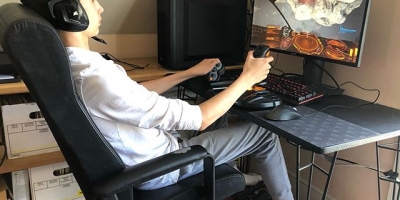
Image of the Pleiades by Joe Roberts “borrowed” from here
Two weekends ago, the family and I visited the Santa Barbara Museum of Natural History for one of the SB Astronomical Unit’s monthly Star Parties. It was a blast! We saw a bunch of cool stuff including Mars, the Pleiades, the Orion Nebula, Bode’s Galaxy, and the Cigar Galaxy amongst many others.
It was so much fun, this past Saturday we went up to attend the SBAU’s Messier Marathon at the Winchester Canyon Gun Club. The conditions were pretty good right after sundown and we got some great views of the Moon, Venus, Mars, and Saturn.
When the kids got tired, I took them home and then headed back up for another round, where I saw the Alcor and Mizar (the binary stars in the handle of the Big Dipper), as well as the Beehive Galaxy and a number of other galaxies and nebulae whose names and/or Messier numbers I can’t recall right now. I also learned to identify a number of new-to-me stars and constellations, including Hercules, Corona Borealis, Corvus, Virgo and more. So much fun!!
Dobsonians For The Win
We (meaning mainly my wife and I) were most impressed by the Dobsonian telescopes. They are big, simple to use, can be built at home without sophisticated tools, and give great views. The fact that they offer the greatest value for money compared to other telescope types doesn’t hurt, either. I’m also personally turned on by the absolute simplicity of the Dobsonian mount and its very “hands-on” nature.
As I’ve learned, a Dobsonian is an instrument that, by comparison to a cutting-edge computerized “Go-To” telescope, requires that you do all the “hard work” yourself. With a Goto, you type in the name of the object (planet, star, galaxy, nebula, etc.) that you want to see, and the mount automatically rotates and centers said object in your viewfinder and then tracks it as it moves across the sky. My dad would love Goto, it’s extremely convenient and gets you on-target immediately. Which leaves me cold…
where’s the soul, man?
With a traditional Dobsonian, you have to do the locating, moving, centering and subsequent tracking completely on your own, with nothing more than the aid of a star chart, some sort of sighting apparatus, a bit of skill, an ounce of luck, and some good old fashioned hand-eye coordination. All of which, of course, completely appeals to both my inner Luddite and outer nonconformist 😉
Reading List – Amateur Telescope Construction
- How to Make a Telescope, Second Edition by Jean Texereau
- Build Your Own Telescope by Richard Berry
- Standard Handbook for Telescope Making by Neale E. Howard
Reading List – General Astronomy
- Turn Left at Orion by Dan M. Davis
- The Universe in a Nutshell by Stephen Hawking
- Bad Astronomy: Misconceptions and Misuses Revealed, from Astrology to the Moon Landing “Hoax” by Phillip Plait
Websites – Information & Discussion
- Santa Barbara Astronomical Unit
- Stellarium: Open Source Planetarium Software
- CloudyNights Forum
- Utah Skies
- Complete Sun and Moon for One Day
- Astronomy from the Ground Up
- Night Sky Network: Astronomy Outreach and Education Resources
- NASA International Year of Astronomy 2009
- Seeing in the Dark – For Families


